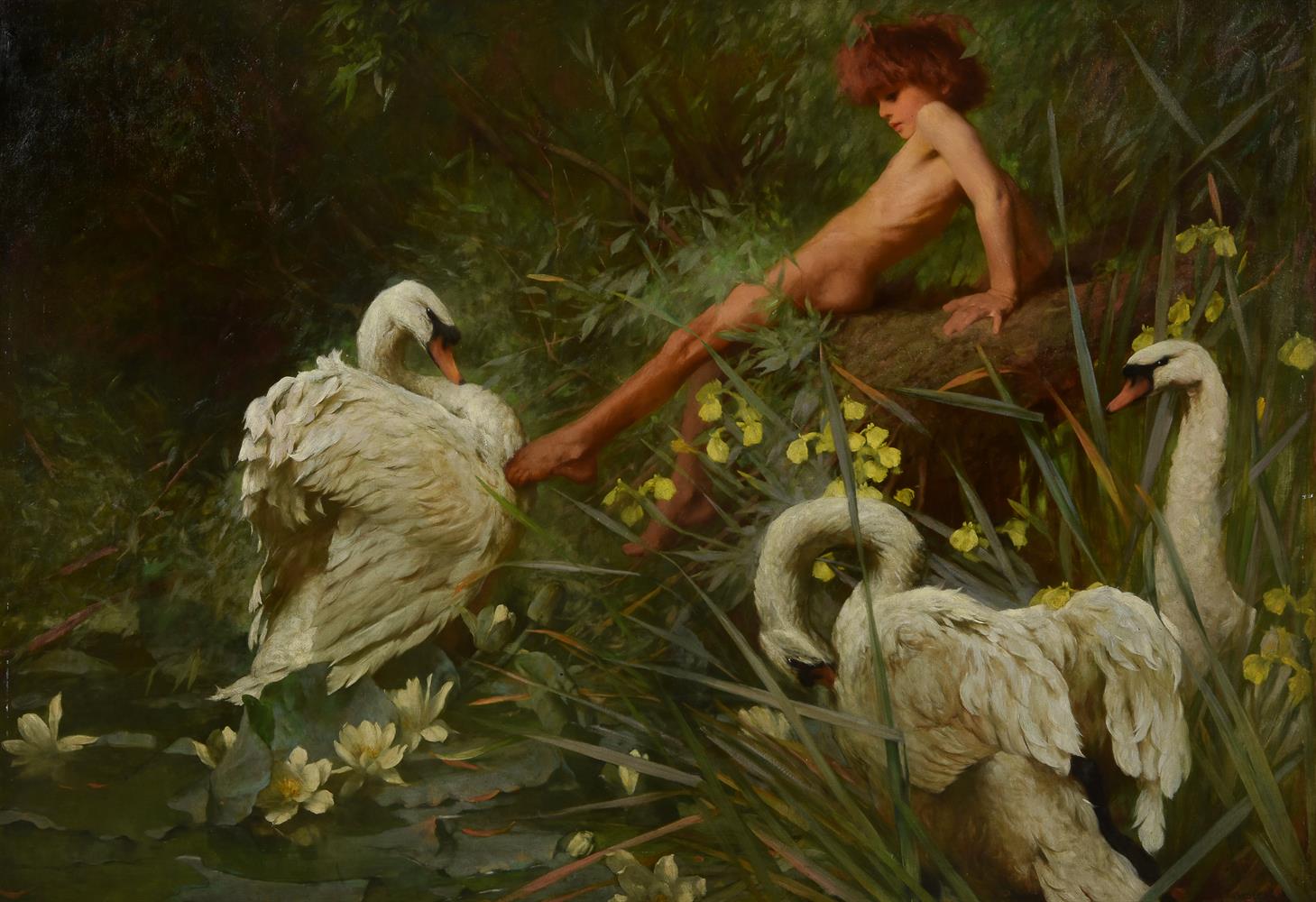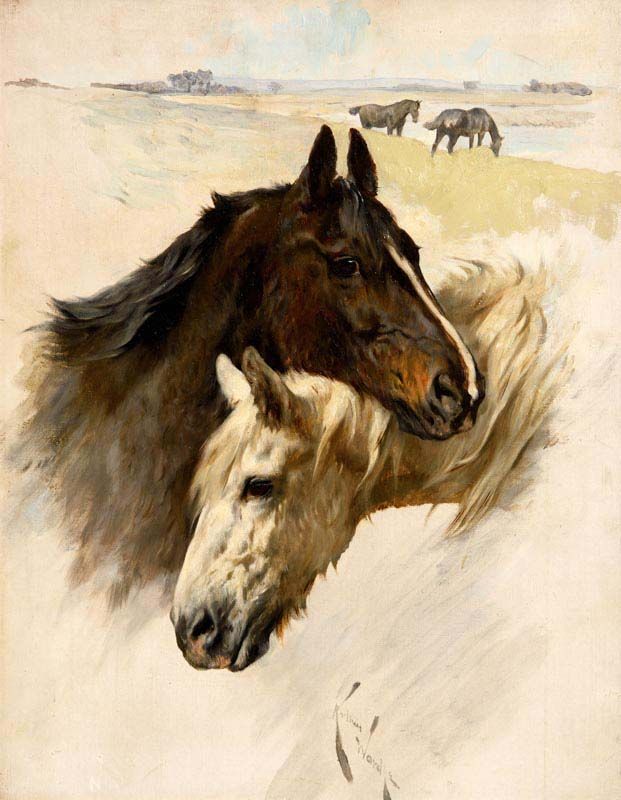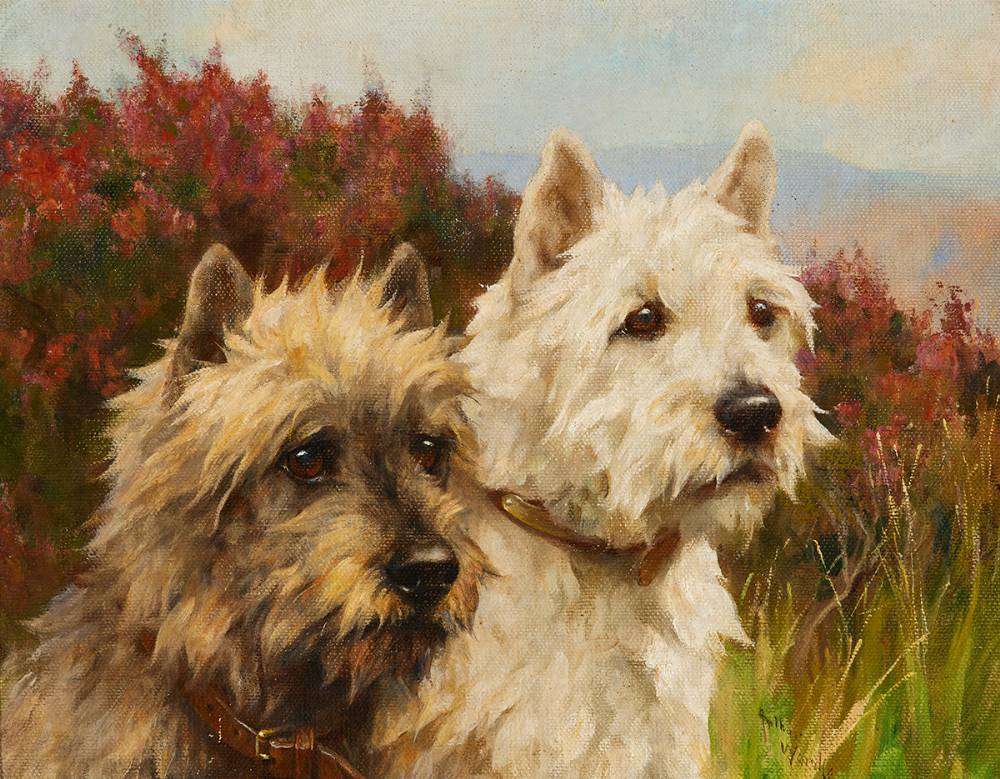ARTHUR WARDLE (BRITISH 1864-1949) AN IDYLL OF SUMMER Oil on canvas Signed (lower right), numbered '329' (verso) 108 x 153cm (42½ x 60 in.)Exhibited: London, Royal Academy, 1900, no. 329 Illustrated: Royal Academy Pictures, 1900, p. 15 Arthur Wardle was one of the most highly regarded and versatile animal painters of the late nineteenth and early twentieth century. He exhibited at the Royal Academy for over fifty-five years and showed An Idyll of Summer in 1900 when he was thirty five. Many of his works show animals, mostly dogs, in their natural environments, but a number of his pictures, including many of his most important exhibition pieces, include humans, such as his 1895 Royal Academy exhibit A Fairy Tale, (Christie's 11 July 2013, lot 4, £337,875). He was an academic artist by temperament and he would have been very conscious of the tradition of a hierarchy of subjects, 'history painting' representing the highest form of artistic expression followed by portraiture, genre, landscape, animal painting and still life. By making animals the protagonists of 'historical' subjects he was having the best of both worlds, claiming the pictorial high ground while remaining true to his field of expertise. Occasionally he would attempt a classical theme, 'history' in its purest form. More often Wardle opted for inventions of his own such as An Idyll of Summer which, while being a bucolic celebration of youth, may also allude to the mythological figure of Cygnus, who appeared in many myths, most of which led to his transformation into a swan. Wardle may be thinking of either Cygnus, the handsome son of Apollo who, together with his mother Thyrie, was transformed into a swan, or possibly Cygnus son of Poseidon. In this tale, he was abandoned on a beach as a baby and subsequently rescued by fishermen who, inspired by a flock of swans flying overhead and his pale complexion, called him Cygnus. He would go on to gain a reputation as a warrior during the Trojan Wars and on his death Poseidon transformed him into a swan.
ARTHUR WARDLE (BRITISH 1864-1949) AN IDYLL OF SUMMER Oil on canvas Signed (lower right), numbered '329' (verso) 108 x 153cm (42½ x 60 in.)Exhibited: London, Royal Academy, 1900, no. 329 Illustrated: Royal Academy Pictures, 1900, p. 15 Arthur Wardle was one of the most highly regarded and versatile animal painters of the late nineteenth and early twentieth century. He exhibited at the Royal Academy for over fifty-five years and showed An Idyll of Summer in 1900 when he was thirty five. Many of his works show animals, mostly dogs, in their natural environments, but a number of his pictures, including many of his most important exhibition pieces, include humans, such as his 1895 Royal Academy exhibit A Fairy Tale, (Christie's 11 July 2013, lot 4, £337,875). He was an academic artist by temperament and he would have been very conscious of the tradition of a hierarchy of subjects, 'history painting' representing the highest form of artistic expression followed by portraiture, genre, landscape, animal painting and still life. By making animals the protagonists of 'historical' subjects he was having the best of both worlds, claiming the pictorial high ground while remaining true to his field of expertise. Occasionally he would attempt a classical theme, 'history' in its purest form. More often Wardle opted for inventions of his own such as An Idyll of Summer which, while being a bucolic celebration of youth, may also allude to the mythological figure of Cygnus, who appeared in many myths, most of which led to his transformation into a swan. Wardle may be thinking of either Cygnus, the handsome son of Apollo who, together with his mother Thyrie, was transformed into a swan, or possibly Cygnus son of Poseidon. In this tale, he was abandoned on a beach as a baby and subsequently rescued by fishermen who, inspired by a flock of swans flying overhead and his pale complexion, called him Cygnus. He would go on to gain a reputation as a warrior during the Trojan Wars and on his death Poseidon transformed him into a swan.















Testen Sie LotSearch und seine Premium-Features 7 Tage - ohne Kosten!
Lassen Sie sich automatisch über neue Objekte in kommenden Auktionen benachrichtigen.
Suchauftrag anlegen